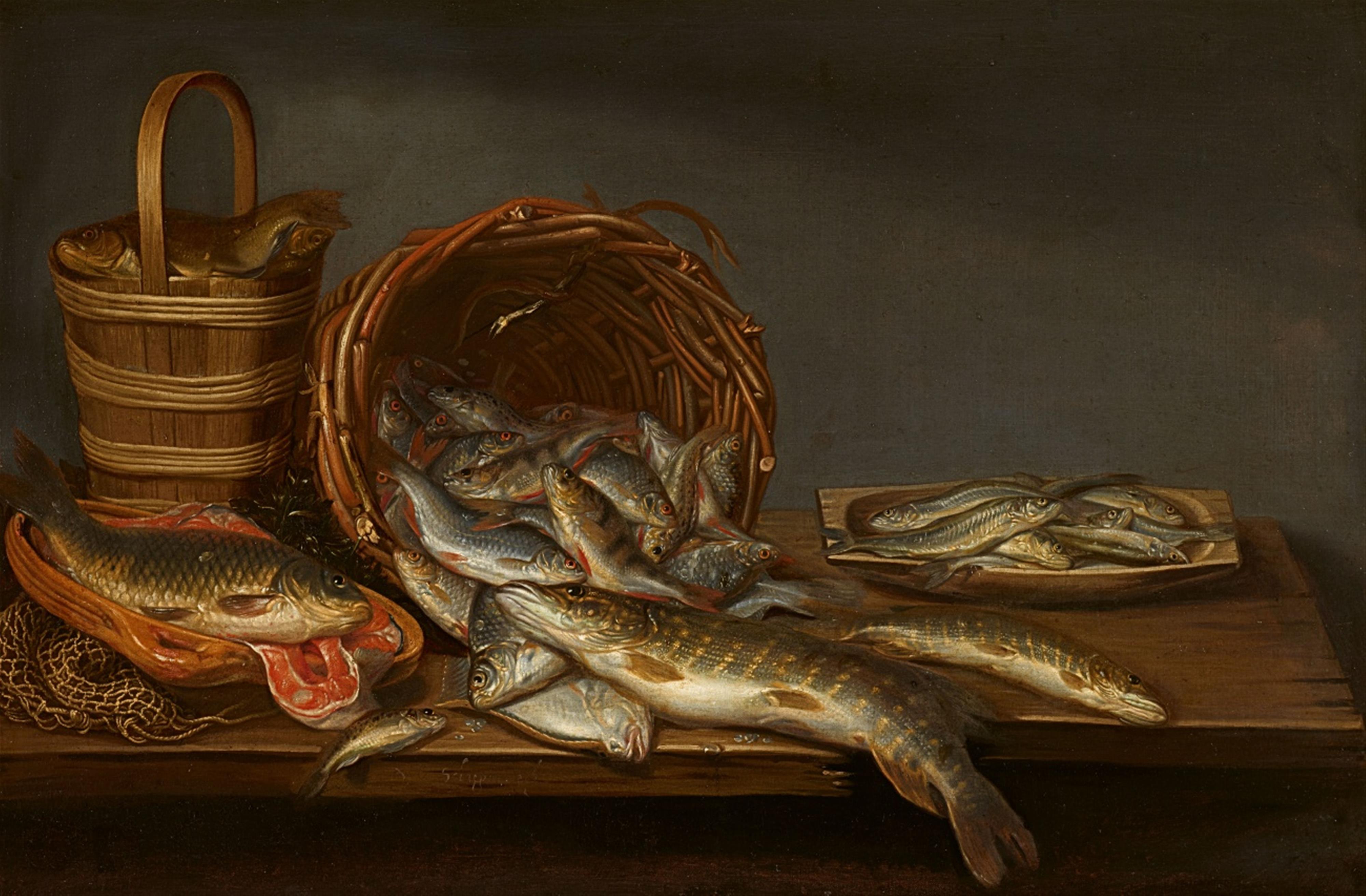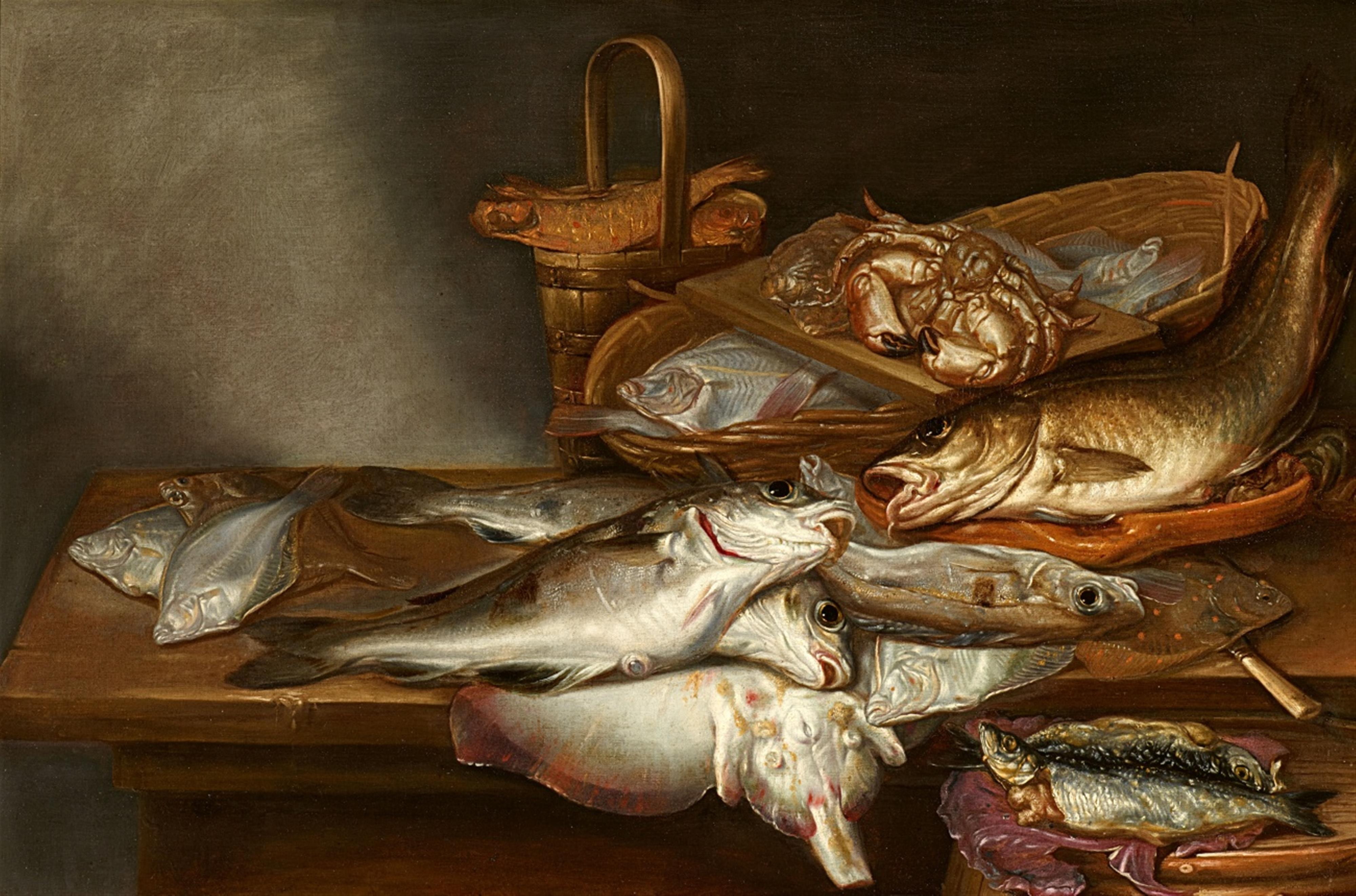Pieter van Schaeyenborgh
Still Life with Freshwater Fish / Still Life with Saltwater Fish
Oil on canvas (relined). Each 73 x 112 cm.
Signed lower centre: Schaeyenborgh (Still Life with Freshwater Fish); remnants of a signature (Still Life with Saltwater Fish).
As Fred G. Meijer has stated, these two paintings by Pieter van Schaeyenborgh occupy a special place in the history of Dutch fish still lifes (op. Cit., 300), owing to the fact that they are probably the only examples of the genre, whose provenance can be traced back to the time of the commission. They thus provide us with a clear picture of the paintings' original purpose. The works decorated the Provenhuis van Nordingen in Alkmaar for more than 200 years before being transferred to the Stedelijk Museum in Alkmaar in the 19th century, then returned to the Provenhuis for a time before finally being divided and sold in 1974. It was through a stroke of luck that they were reunited and today and now form a pair as originally intended.
In these two still lifes, Pieter van Schaeyenborgh depicts saltwater and freshwater fish, spread out on wooden tables before the beholder. The freshwater fish are silver bream, salmon, plaice, tench, pike, smelt and ruffe; the saltwater fish are herring, haddock, cod, flounder, ray and a crab. Van Schaeyenborgh uses scintillating brushstrokes to illustrate the diversity of the fish species, their different - sometimes exotic - shapes and sizes, but above all the different colours and textures of their scales, at times shimmering silver, sometimes bluish, sometimes in light ochre tones, but always utilising vivid accent colours.
These still lifes illustrate the quality of van Schaeyenborgh's painting, which Gemar-Koeltzsch characterized as follows: "Van Schaeyenorgh's brisk brushwork and his characterization of the fish can rightly be judged as excellent. Above all, however, the painter demonstrates the mastery of colour in his animal depictions" (Gemar-Koeltzsch, op. cit., p. 897). The two compositions were chosen to act as counterparts to one another: The arrangement of the fish is dominated by a diagonal line, with one large fish forming the center of the composition. Around it, the artist arranges the various other fish alongside objects such as baskets, wooden buckets, bowls and plates.
At the time they were painted, one still life cost 47 gulden, the other 42 gulden. This was many times what works by van Schaenborgh, but also fish still lifes by other artists, usually cost. The high prices illustrate the importance that both the artist and the client attached to these two works. The client in question was Johan van Nordingen, a member of a wealthy family from Alkmaar. His father of the same name was originally from The Hague and was a respected lawyer, his wife Maria van Steenhuijsen belonged to one of the leading families of Alkmaar, and his father-in-law was the founder of the Alkmaar East India Company. With this cosmopolitan background, the family knew exactly which artists to turn to for commissions. For example, Johan van Nordingen ordered portraits of himself and his wife (fig. 1) from Caesar van Everdingen, an artist who would later be involved in the most important public commission at the time in the Netherlands, the painting of Huis ten Bosch in The Hague.
Thus, he commissioned Pieter van Schaenborgh to paint two fish still lifes. This commission was part of a larger legacy: In his will, Johan van Nordingen decreed that his fortune should be used to build a house for the Impoverished, the Provenhuis. Also called the Huis van Achten because of its eight inhabitants, the building of the Provenhuis has survived to this day (fig. 2). Payment documents show that the still lifes were delivered in 1656 and 1657. An inventory from 1685 later records that the works were placed in the most important room of the Provenhuis, the "Regentekamer", where they were displayed next to the group portrait of the "Heeren Regenten", the heads of the house, which was so typical of the northern Netherlands: "Een schilderije van zee vissen" and "Een van Rivier vis van glijcke formaet" (Dalderup, op. cit., Appendix III).Inventories of Dutch art collections from the second half of the 17th century show us that fish still lifes were especially appreciated by collectors from the patrician classes. Fish still lifes had their origin in the Dutch market and kitchen paintings of the 16th century, but they developed into an independent genre at the beginning of the 17th century. The fish still lifes were an expression of the national pride of a seafaring nation with a highly developed fishing industry - especially at sea - which was of central importance for the national economy as well as for the nutrition of the population. This explains why Johan van Nordingen commissioned the pair of fish still lifes from Pieter van Schaeyenborgh to decorate the most important room in the Provenhuis in Alkmaar, which still bears his name today.
We would like to thank Seya Dalderup for information on the provenance of the paintings and for providing us with the unpublished manuscript about the art collection of the van Nordingen family.
Provenance
Johan van Nordingen the Younger fort he Provenhuis van Nordingen, Alkmaar, 1656/57-1875. – As permanent loan to the Stedelijk Museum Alkmaar, Alkmaar 1875-1905 (Inv. no. 229/230; verso label). – Provenhuis van Nordingen, Alkmaar, 1905-1974. –Mark van Way, Amsterdam, 1.5.1974, lot 246 and 247. – With C.P.A. & G.R. Castendijk, Rotterdam, 1974. – (one still life: Private collection, Netherlands, 1975). – With Hoogsteder & Hoogsteder, The Hague, 2004. – Private collection, Netherlands.
Literature
Fred G. Meijer: Fish Still Lifes in Holland and Flanders, in: Exhib. cat.: Utrecht 2004: Fish – Still Lifes by Dutch and Flemish Masters 1550-1700, no. 71.
Exhibitions
“Fish – Still Lifes by Dutch and Flemish Masters 1550-1700”, Centraal Museum Utrecht 2004, no. 40.




